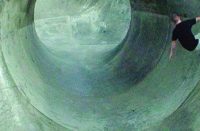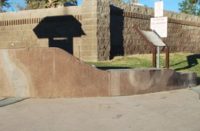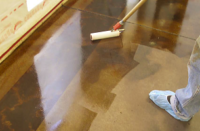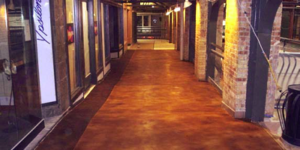On the lookout to make the job of prepping concrete surfaces safer, quicker and more environmentally friendly, many concrete decorators have added a new tool to their arsenal: Tek Gel, a gelled acid solution from Surface Gel Tek LLC.

Gel Tek’s acid solution to the tribal seal.
Gelled acid solution is a concept proven to give craftspeople more control than ever before when “opening up” smooth steel-troweled concrete surfaces. As its name implies, Tek Gel is a chemical compound in which the profiling agent, hydrochloric acid, remains suspended in a gelatinous form until contact is made with the lime, calcium and salts that typically comprise concrete.
Application is so simple that a 15-minute tutorial is all that’s needed. Brush, squeegee, roll or spray the gelled acid solution onto concrete in a uniform fashion, then rinse away. The process creates a gripping surface for subsequent coatings and removes rust, mold, algae, laitance, efflorescence and mineral deposits, leaving no soap, slime or residue on the surface. The manufacturer advises following up the acid treatment with a 2,000-psi pressure wash to remove any reactive salts.

Ground control
The proper anchor profile is achieved simply by selecting the right Surface Gel Tek product. Concrete decorators involved in stenciling, coloring or microtopping often choose Tek Gel for Flattooing (named after the manufacturer’s in-house stencil), which leaves a “soft suede” anchor profile suitable for such work. For more toothy profiles, Tek Gel for Profiling (about 120 grit) and HD24 Industrial Profiling (about 80-60 grit) are also available.
Besides improving the bond between concrete, coating and treatment, a gelled acid solution does not bleed or penetrate too deeply into a substrate. This gives artisans crisper, cleaner separation of lines and boundaries used to create shapes and lettering.
 “You apply the gelled acid where you want and nowhere else,” says Surface Gel Tek chief executive officer Tamryn Doolan. “When you look at it under a microscope, Tek Gel creates a little bit of a wall as it etches. When colors are applied, especially with our thickener called Stain Mule, the colors hit a microscopic wall, offering perfect color placement.”
“You apply the gelled acid where you want and nowhere else,” says Surface Gel Tek chief executive officer Tamryn Doolan. “When you look at it under a microscope, Tek Gel creates a little bit of a wall as it etches. When colors are applied, especially with our thickener called Stain Mule, the colors hit a microscopic wall, offering perfect color placement.”
In contrast, liquid hydrochloric acid, an old standby, may weep into bordering areas not meant to be treated. Moreover, liquid acid may penetrate so deeply beneath the concrete surface that it cannot be removed, which may leave a soft spot. “Will that cause a problem?” Doolan asks. “Maybe. Maybe not. But if you can avoid that possibility, you’re better off.”
Work showcased
Professionals thus far have used Tek Gel products in some pretty impressive places: The gelled acid solution and stencil were used to create the official seal of the Yavapai Nation on the floor of the Tribal Justice Building at Fort McDowell, Ariz. The main lobby floor of The Gap Inc.’s headquarters in San Francisco received a gelled acid solution treatment to help achieve a retro look.
Gelled acid solution works especially well in high-traffic areas where dust and noise pollution are concerns.
“You avoid airborne silica dust associated with sandblasting and the loud noises created by power equipment,” Doolan says. “Best of all, you don’t necessarily have to have power at the job site. The materials and equipment you bring are usually all you’ll need.”
While surface prep machines such as shot blasters and scarifiers work well in large, open and unobstructed spaces, gelled acid solution is more easily applied in corners and around columns or posts that most machines simply cannot reach. Skilled applicators can even take their work vertical by using Tek Gel on stair risers, walls — and even ceilings.
Those wishing to delve deeper into the design process — for instance, to request that the concrete be finished without curing agents that might impair acids — may wish to seek approval of the project’s architect and general contractor beforehand. A good way to tell if the concrete contains a sealer or additive that may block the acid is to sprinkle a cup of water on the pad. “If it beads up, then that means there’s a sealer or other compound on the surface that will prevent other products from sinking in,” Doolan says. “It will walk off, delaminate or otherwise fail.”
While working with Tek Gel or any acid solution, applicators are urged to follow established safety procedures, such as wearing eye protection, adequately covering exposed skin and using proper breathing equipment.
“Prep work is often a tedious and boring job, but one that should never be taken lightly,” says Doolan. “Eighty percent of all coating failures may be directly traced to inadequate or improper surface preparation.”
Surface Gel Tek offers technical schooling for those interested in working with gelled acid solutions and stencils.
(480) 970-4580
www.surfacegeltek.com

















